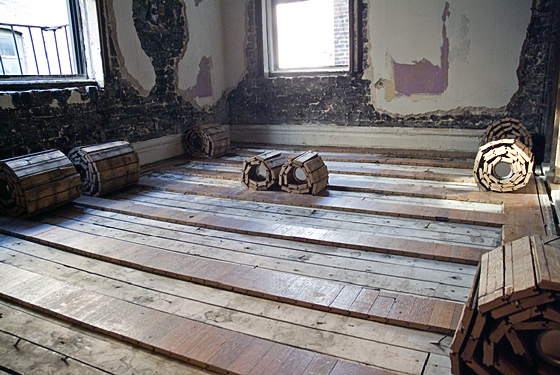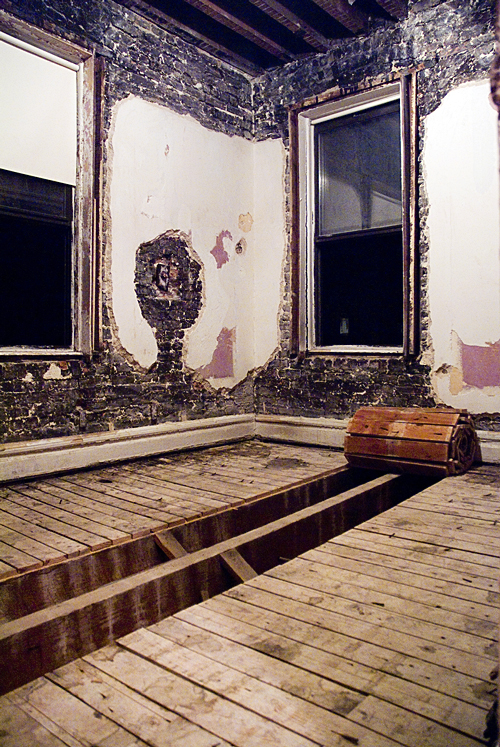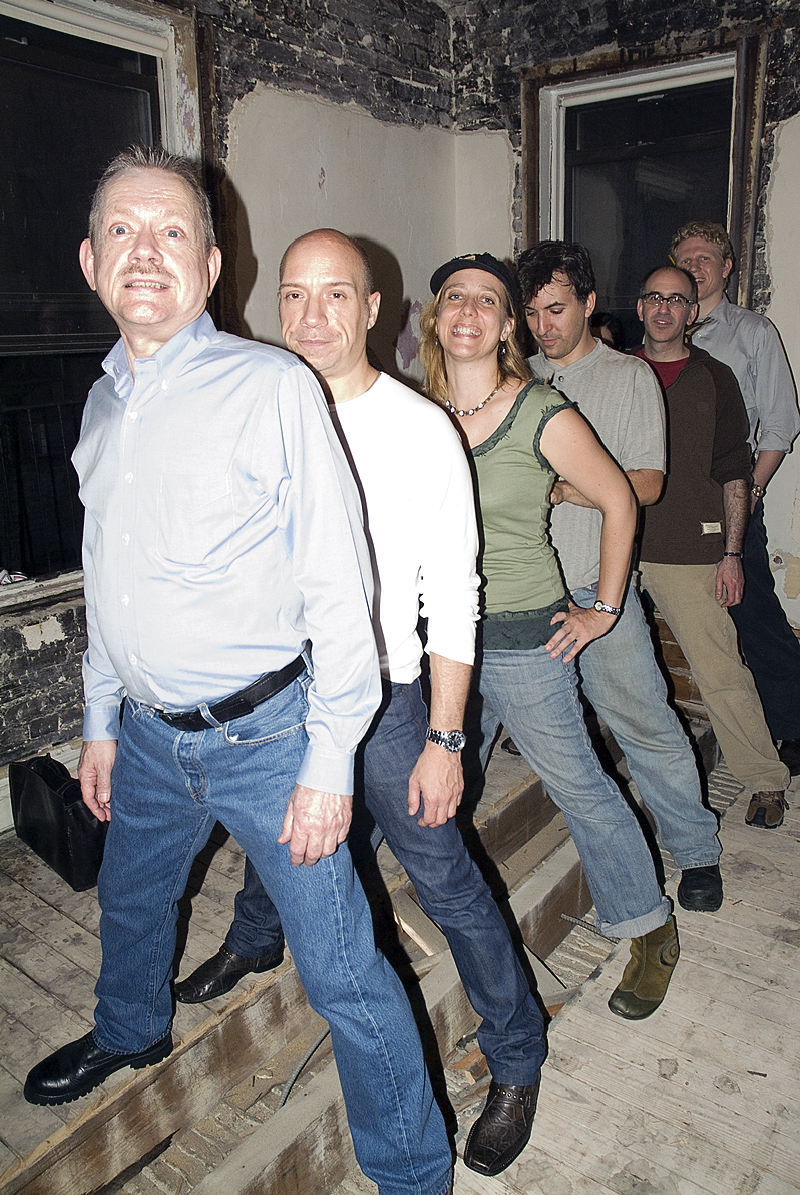I've stated before, in multiple places and multiple times, that I don't approve of installation art or conceptual art. I say "I don't approve," with its overtones of patrician regard and aloof moralizing, very particularly to make it clear that I know I'm being obtuse and retrograde in my thinking. Also to make it easy for anyone who wants to disagree with me, since it's clear I'm a pompous prick.
But if I don't approve of installation art, I am also a sucker for reverse psychology. Basically I enjoy proving people wrong whenever possible -- it's something of a hobby of mine, in fact. So when Joe Giannasio wrote on Ed Winkleman's blog (which blog I've had a lot of time to read and comment on thanks to my current (and thankfully temporary) non-job in Cubicle America) that he had trouble getting people to the apartments where he installs his installation art -- one critic, he claims, said "I don't go to shows that aren't in public spaces" -- when Joe said he couldn't get people to his openings, I had to prove him wrong and show up. Even if I don't usually like installation art.
I do, however, love New York and its buildings. I grew up in a hundred-year-old house in a historic neighborhood in the city, although really all neighborhoods in the city are historic in some sense. I'm currently living in a house built in 1928 and I have a thing for the architectural peculiarities of that time, like really nice woodwork. My father is a handy guy and when I was young I'd watch him repair or replace something all the time, marveling at the innards of this or that antique appliance or dusty niche of the basement. I still have this part of me which insists on attempting to be handy myself even though I'm about as dextrous with tools as a half-crushed ladybug. For example, a few years back I invested many hours in stripping seventy years of paint from the wood around my bathroom window, exposing some beautiful American chestnut and the pencil marks of the craftsman who built it three generations earlier. Then I went and half-stripped one of the windows in my daughter's bedroom and there I stopped. I'm going to finish it up any day now. Any day.
And Joe Giannasio's work is about the layers of construction in the rooms in which we live and work. What he does is peel back -- partly, literally -- the layers between the inhabitants of the room and the structure of the room itself. I could invent something metaphorical here and relate this to all sorts of things -- uncovering hidden layers of meaning in the structure of daily life and so forth -- but I don't think it's fair to the work, which is ultimately straightforward: Here, Joe is saying, this is what it's made of. Check it out.

Joseph Giannasio, 9-11 CPN Project, "Infinite Knot", 2007. Photo courtesy the artist.

Joseph Giannasio, 9-11 CPN Project, "36 Boards" in progress, 2007, detail. Photo courtesy the artist.

Joseph Giannasio, 9-11 CPN Project, "36 Boards", 2007. Photo courtesy the artist.
As he worked more visitors arrived, including Stephanie. Then Joe finished, cleaned up some of the more egregious dust and dirt, and allowed everyone in to stand around inside the work.
Then an amazing thing happened. The piece became interactive. We all began to talk -- something nearly impossible at most noisy Chelsea openings -- and discuss the exposed details. One person noticed that the rusty ironwork poking through the brick was the support for the fire escape outside the window. We all speculated on why the brick was black on the side facing us (tar for waterproofing was our best guess). We talked about the history of New York City and the neighborhoods we'd seen change. Joe and his friend Vince spoke in shocked tones about how different Central Park North was even in the few years Joe had lived there; I myself was surprised because the area was one of the triumvirate of fabled Bad Neighborhoods of my youth -- Harlem, Bedford-Stuyvesant, and the South Bronx. Another visitor told me how even the South Bronx is being gentrified, which is a little like hearing that Disney's opened a new park in Antarctica. And speaking of Disney, we lamented the loss of Times Square to Disneyfication. Then, emboldened by her consumption of one lukewarm can of Budweiser, Stephanie did a balance beam routine on the exposed joist, but didn't do any flips despite our encouragement.

9-11 CPN Project, "36 Boards" with visitors. Stephanie is third from the left, with her boyfriend Moby Dick behind her, followed by the artist's friend Vince. I'm unclear on who everyone else is, but they were all fun to talk to. (Joe wrote to me to tell me: "The other people in the photo are starting left Larry, Steve, and the far right, Ben.") Photo courtesy the artist.
I don't know how, exactly, one could import that into a place like Chelsea. I'm not sure it'd even be possible to make work in a gallery or museum. And I'm not really sure what Joe did was much different from simply arranging a small gathering. I feel like maybe I'm shortchanging his artwork by reducing it to the background for a cocktail party.
And yet it was one of the better art experiences I've had. And that's not something to be taken lightly. I doubt that many pieces I've seen could even sustain as much conversation as this one did; and certainly the environment in which they'd be viewed isn't exactly conducive to it.
Stephanie, almost every time I see her, says, just before we part, "Well, I had a nice time." She usually sounds mildly surprised, as if she expected time with me would be unpleasant, or anyway boring. She said it this time and I, for once, really agreed wholeheartedly: Joe's show was a nice time and I was surprised by it.


Chris the last photograph reminds me of a debutant and her imagined beaus at a high school reunion .
'Imagined'? They don't look imaginary to me!And I'm not 'surprised to have had a nice time' with YOU, dear Chris, as we have had a nice time sitting in a basement room for six hours (with Danny, of course, but I am certain that even without Danny we'd think of things to talk about) but 'surprised to have had a nice time' in CHELSEA. You do not, perhaps, understand the sorts of screaming horrors that excursions to hip happening lame art exhibitions have occasioned in my not-so-distant past.
I really don't know what to make of that.I mean I understand the concept of architecture as art, and even non-functional architecture as a (very expensive) artistic medium.And without being there, it is partly only imagined, but I can get the sense of the artistic in this.But also burning in my mind is the question, "Now what?"You've got an apartment that's been converted into an art piece. And? Like you said, you can't exactly pack this up and put it on display somewhere else... Do you keep inviting small groups of people to come experience it, and maybe make it come alive in the same way? Time to remodel and put it back together again?And oh! Then the practical in me rises up and begins to weep at all that real hardwood flooring turned into just so much kindling! Augh!!
DC, he remodels the apartments after he strips them. These are 'temporary installations.'
I was also horrified initially that Joe'd torn up some real hardwood flooring. I mentioned it to Joe and he assured me that the floor hadn't been all that great to start with and then had been ruined anyway.Apparently -- I didn't get the full story, but -- apparently this piece began when the guy actually living in the room decided to start remodeling it himself. He ended up disasterizing the room. That's when Joe came in, offering to remodel the room properly in exchange for using it as an art piece for a little while.Joe had carefully stashed all the room's wood moulding in the rafters, too. So he saved what he could. He's not just a wrecking ball.
Interesting, wish I had seen it. Very Gordon Matta-Clark.
Oh my goodness.As a former resident of both New Orleans and Chicago, the type of experience you're talking about here is quite familiar.The breathing in of layered years of *ordinary house art* - often interwoven with layers of excruciating dross - is almost transcendent.I feel things in buildings, sometimes. Different things, different ways.One time I stripped about 145 years' worth of paint from a beautiful fireplace mantle and cartouche, and then the same from the original cypress door frame in that room. Everything came off just fine except the very earliest layer of paint.That's when I got an brief education on the makeup of Victorian-era house paint. They used things like a milk base, and egg ingredients at times. That first layer - painted around 1853 - was in pristine condition. Beautiful, smooth, unmarred, unfaded paint.And it was impossible to remove. It had bonded with the wood, perfectly, without seeming to penetrate it at all.It was extraordinary. Running my fingers over that paint was shivery.I could go on like this for HOURS and hours and hours.They're alive, sometimes, those old places.
last time I tried to find your blog it had disappeared..I'll out you back on my links.word